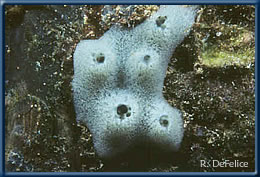

Haliclona caerulea

Gelliodes fibrosa

Suberites zeteki

Zygomycale parishii

Mycale armata
Haliclona (Sigmadocia) caerulea
 Blue
Caribbean sponge
Blue
Caribbean sponge
Phylum Porifera
Class Demospongiae
Subclass Ceractinomorpha
Order Haplosclerida
Family Chalinidae
Description
Growth Form
Thickly encrusting or massive (irregular, solid form) sponge with raised
thick-walled volcano-shaped oscules, up to several centimeters in height.
Color
Exterior is pale blue-green, interior color is a dirty yellow.
Texture and Surface Features
Specimens are soft and easily torn. Surface is even, somewhat smooth,
like fine sandpaper.
 Spicules
Spicules
Megascleres: bent oxeas (170-230 mm). Microscleres: sharply curved
C-shaped sigmas (25 mm).
Habitat
In the Hawaiian Islands, H. caerulea is mainly
restricted to shallow-water fouling communities (i.e. pier pilings, floating
docks) of the major harbors on Oahu or associated disturbed habitats (i.e.
dredged channels and artificial lagoons). It is also found on the roots
of the nonindigenous Red Mangrove, Rhizophora mangle, native to Florida,
West Indies, and South America, which is abundant in Pearl Harbor and
Keehi Lagoon. In Kaneohe Bay, H. caerulea is found on patch reefs in southeast
corner of the bay as well as the fouling community on Coconut Island floating
docks.
Distribution
Hawaiian Islands
Oahu - Pearl Harbor, Honolulu Harbor, Keehi Lagoon, Kewalo Basin, Ala
Wai Harbor, and Kaneohe Bay.
Kauai - Nawiliwili Harbor.
Midway Atoll - main harbor.
Mechanism of Introduction
Unintentional introduction, most likely as fouling on ships' hull.
Native Range
Caribbean or Eastern Pacific (Panama)
Present Distribution
Caribbean, eastern Pacific at Panama, main Hawaiian Islands, and Guam.
Impact
Fouling organism. Ecological impact unstudied, but probably some competition
for space with native species.
Ecology
Feeding
Like all shallow-water sponges, H. caerulea
is a filter feeder, continuously circulating water through their bodies.
Microscopic food particles are removed from water by specialized collar
cells. Digestion is intracellular.
Reproduction
H. caerulea is capable of asexual reproduction
by fragmentation of the adult. Details regarding sexual reproduction of
this species are unstudied. Many sponges are sequentially hermaphroditic.
These sponges reproduce sexually by capturing sperm that has been released
into the water column by adjacent individuals and transporting it to an
awaiting egg deep within the sponges aquiferous system. The embryo may
be released shortly after fertilization or held for further development.
The embryo released is typically a motile larva, which after a time in
the plankton, settles to the bottom and develops into a young sponge.
Remarks
This sponge is considered to be a recently unintentionally introduced
species due to its sudden appearance in the islands and widespread disjunct
geographic distribution (Caribbean and Hawaiian Islands). De Laubenfels
(1950) and Bergquist (1967) both conducted sponge surveys on the floating
docks on Coconut Island in Kaneohe Bay, Oahu where H.
caerulea is now abundant. It is unlikely that this conspicuous
species was present but overlooked by these researchers.
Haliclona caerulea from the Caribbean, was
first described from Jamaica by Hechtel (1965). He reports this species
as common on pilings and mangrove roots, as well as in a sandy turtle
grass bed. Van Soest (1980) reports the species from mangrove roots and
intertidal rocks in the Caribbean. Wulff (1996) also collected H. caerulea
from mangrove roots in the Caribbean, but noted that eastern Pacific specimens
were only found associated with the bases of branching pocilloporid corals.
Introduction to Hawaii was most likely by means of fouling on a ship's
hull. H. caerulea was previously only known
from the Caribbean and the eastern Pacific at Panama. The initial inoculation
point was probably Honolulu or Pearl Harbor on Oahu. It now also occurs
in the main harbor on Kauai, but was not found on any other neighboring
main islands when surveys were conducted in 1997. H.
caerulea was recently transported from Pearl Harbor to Guam on
the hull of a floating dry dock. It remains to be seen whether this sponge
will become established there.
References
Bergquist, P. R. 1967. Additions to the sponge fauna of the Hawaiian Islands.
Micronesica. 3: 159-174.
Hechtel, G. J. 1965. A systematic study of the Demospongiae of Port Royal,
Jamaica. Peabody Mus. Nat. Hist. Bull. 20: 1-103.
Laubenfels, M. W. de. 1950. The sponges of Kaneohe Bay, Oahu. Pac. Sci.
4(1): 3-36.
Soest, R.W.M. van. 1980. Marine sponges from Curacao and other Caribbean
localities. Part II. Haplosclerida. Stud. Fauna Curacao. 62(191): 1-173.
Wulff, J. 1996. Do the same species of sponges live on both sides of the
isthmus of Panama? in Recent Advances in Sponge Biodiversity and Inventory
and Documentation, Bull. Inst. Royal Sci. Nat. Belgique. 66: 165-173.
© 2002 Hawaii Biological Survey, Bishop Museum
contact